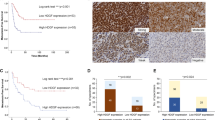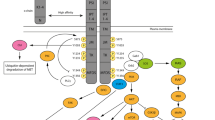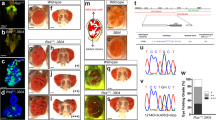Abstract
Aberrations in Met-hepatocyte growth factor/scatter factor (HGF/SF) signaling have been implicated in the acquisition of tumorigenic and metastatic phenotypes. Here we show that murine NIH3T3 and C127 cells transformed by the Ras oncogene overexpress the Met receptor, resulting in enhanced HGF/SF-mediated responses in vitro including invasion through basement membrane. Accompanying the increase in Met in ras-transformed NIH3T3 cells, there is a decrease in endogenous HGF/SF expression as previously observed in cells exogenously overexpressing Met. However, subcutaneously grown tumors and experimental lung metastases derived from these cells express significantly higher levels of endogenous HGF/SF together with high levels of Met. These results suggest Met-HGF/SF signaling enhances tumor growth and metastasis of Ras-transformed NIH3T3 cells.
This is a preview of subscription content, access via your institution
Access options
Subscribe to this journal
Receive 50 print issues and online access
$259.00 per year
only $5.18 per issue
Buy this article
- Purchase on Springer Link
- Instant access to full article PDF
Prices may be subject to local taxes which are calculated during checkout
Similar content being viewed by others
Author information
Authors and Affiliations
Rights and permissions
About this article
Cite this article
Webb, C., Taylor, G., Jeffers, M. et al. Evidence for a role of Met-HGF/SF during Ras-mediated tumorigenesis/metastasis. Oncogene 17, 2019–2025 (1998). https://doi.org/10.1038/sj.onc.1202135
Received:
Revised:
Accepted:
Published:
Issue Date:
DOI: https://doi.org/10.1038/sj.onc.1202135
Keywords
This article is cited by
-
Intraoperative MET-receptor targeted fluorescent imaging and spectroscopy for lymph node detection in papillary thyroid cancer: novel diagnostic tools for more selective central lymph node compartment dissection
European Journal of Nuclear Medicine and Molecular Imaging (2022)
-
Real-time cellular and molecular dynamics of bi-metallic self-therapeutic nanoparticle in cancer cells
Applied Nanoscience (2018)
-
Long noncoding RNA MRCCAT1 promotes metastasis of clear cell renal cell carcinoma via inhibiting NPR3 and activating p38-MAPK signaling
Molecular Cancer (2017)
-
Quercetin inhibits HGF/c-Met signaling and HGF-stimulated melanoma cell migration and invasion
Molecular Cancer (2015)
-
FN14 expression correlates with MET in NSCLC and promotes MET-driven cell invasion
Clinical & Experimental Metastasis (2014)



